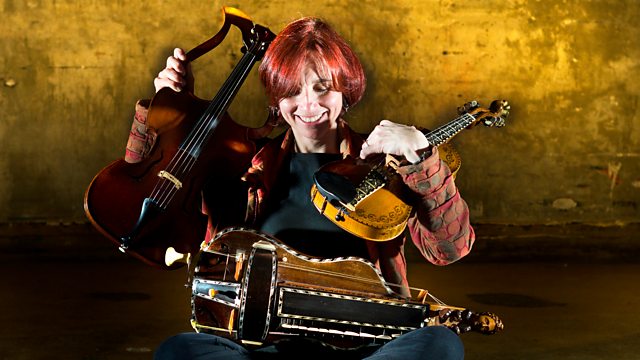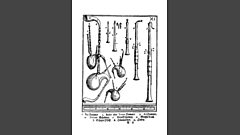
Lost Sounds
Clare Salaman considers why instruments that were once part of musical life - such as the vielle, the bray harp, the hurdy-gurdy and the viola organista - are now rarely heard.
Clare Salaman on forgotten instruments which were once part of everyday musical life.
Clare considers why instruments which were once part of musical life - such as the vielle, the bray harp, the hurdy gurdy and the viola organista - are now rarely heard. Some were particularly suited to certain styles of music and unable to keep up when fashions changed. Others, while astonishing, intriguing and even beautiful in their design proved totally impractical for everyday use. Clare chooses recordings of some of these lost instruments, which create sounds which are very rarely heard today.
Last on
Music Played
-
![]()
The Dufay Collective
ANONYMOUS (Italian 14th Century): Saltarello
- CHANDOS.
- CHAN 9320.
-
![]()
Anonymous (Italian 14th century)
Salterello
Performer: The Dufay Collective. -
![]()
anon
Saltarello
Ensemble: The Dufay Collective.- Chandos.
-
![]()
Tobias Hume
TOBIAS HUME: A Toy / A Merry Meeting
Performer: Alison McGillivray. Performer: Elizabeth Kenny.- DELPHIAN.
- DCD 34140.
-
![]()
Bill Taylor
ANONYMOUS (15th Century Wales): Prodiadiau / Provings
- KATTENBERG RECORDINGS.
- KA 001.
-
![]()
Jean-Baptiste Dupuits
Sonata Op.3`1 for harpsichord and hurdy-gurdy
Performer: Les Maitres de la vielle baroque. Performer: Matthias Loibner. Performer: Riccardo Delfino.- CPO.
- 999 8642.
-
![]()
Tobias Hume
A Toy and A Merry Meeting
Performer: Alison McGillivray. Performer: Elizabeth Kenny.- Delphian.
-
![]()
Anonymous (Welsh 15th century)
Prodiadiau/Provings
Performer: Bill Taylor. -
![]()
anon
Provings
Performer: Bill Taylor.- Kattenberg Recordings.
-
![]()
The Dufay Collective
La Tierche estampie royal for ensemble
- CHANDOS.
- CHAN 9320.
-
![]()
Jean-Baptiste Dupuits
1st, 2nd & 6th movements from Hurdy-Gurdy Sonata No.1, Op.3
Performer: Matthias Loibner. Performer: Riccardo Delfino. Performer: Les Maitres de la vielle baroque. -
![]()
Heinrich Ignaz Franz von Biber
Mystery (Rosary) sonata no. 1 in D minor (The Annunciation) for violin and continuo
Performer: Supersonus.- ECM.
- future release.
-
![]()
Anon, They Move...
Hurdy Gurdy Sonata No 1 Opus 3
Performer: Matthias Loibner. Performer: Riccardo Delfino.- CPO.
-
![]()
Anonymous (French 13th century)
La Tierche Estampie Roial
Performer: The Dufay Collective. -
![]()
anon
La Tierche Estampie Roial
Ensemble: The Dufay Collective. -
![]()
Monsieur de Sainte-Colombe
Concert no. 44 (Les Regrets) for 2 viole da gamba ['67 Concerts a deux violes esgales']
Performer: Slawomir Zubrzycki - Recorded by MIM Brussel (Musical Instruments Museum). -
![]()
Heinrich Ignaz Franz von Biber
Rosary Sonata No.1
Performer: Supersonus (The European Resonance Ensemble). -
![]()
Heinrich Ignaz Franz von Biber
Rosary Sonata No 1
Ensemble: European Resonance Ensemble.- ECM.
-
![]()
Barnaby Brown & Gonville and Caius Coll. Cambridge Choir
Os mutorum [Inchcolm Antiphoner, c. 8thC]
Conductor: Geoffrey Webber.- DELPHIAN.
- DCD-34137.
-
![]()
Giorgio Mainerio
Caro ortolano & saltarello [no.4, Primo libro de balli, 1578] [incipit in notes]
Performer: David Munrow. Performer: Early Music Consort of London.- TESTAMENT.
- SBT-1251.
-
![]()
Monsieur de Sainte Colombe
Concert no. 44 (Les Regrets) for 2 viole da gamba
Performer: Hille Perl. Performer: Lorenz Duftschmid. Performer: Lee Santana. Performer: Andrew Lawrence鈥怟ing.- DEUTSCHE HARMONIA MUNDI : 05472-77373 2.
- Harmonia Mundi.
- 6.
-
![]()
Tarquinio Merula
Hor ch'e tempo di dormire for voice and continuo
Performer: Montserrat Figueras. Performer: Hesperion XXI.- ALIA VOX.
- AV 9826.
-
![]()
Sainte Colombe
Tombeau Les Regrets
Performer: S艂awomir Zubrzycki. -
![]()
Anonymous
Os Mutorum, Lux Cecorum
Performer: Barnaby Brown. Performer: Gonville and Caius Coll. Cambridge Choir. Performer: Geoffrey Webber. -
![]()
anon
Os Mutorum, Lux Cecorum
Performer: Barnaby Brown. Choir: Gonville and Caius Coll. Cambridge Choir. Conductor: Geoffrey Webber.- Delphian.
-
![]()
Giorgio Mainerio
Caro Ortolano
Performer: Early Music Consort of London. Performer: David Munrow. -
![]()
Giorgio Mainerio
Caro Ortolano
Performer: Early Music Consort of London. Conductor: David Munrow.- Testament.
-
![]()
Tarquinio Merula
Hor ch'e tempo di dormiere
Performer: Montserrat Figueras. Performer: Hesp猫rion XXI. -
![]()
Tarquinio Merula
Hor ch'e tempo di dormire
Performer: Montserrat Figueras. Performer: Hesp猫rion XXI.- Alia Vox.
-
![]()
Wolfgang Amadeus Mozart
Piano Sonata No 4 in E flat major, K 282 (3rd mvt)
Performer: Mitsuko Uchida.- Mozart: Complete Piano Sonatas: Mitsuko Uchida.
- Philips.
- 12.
Descriptions of instruments shown in gallery
Bagpipes:
A mouth-blown pipe carries air to a bag, keeping it inflated. The air is then passed through reeds, held in two other pipes. One of these produces a long, sustained note or drone while melodies are played on the other.
Shawm:
The shawm was well established in Europe by the 13th century and was one of the most important double reed instruments of the middle ages and renaissance. The body of the instrument was turned from a single piece of wood and ends with a flared bell. Its short double reed is placed entirely in the players mouth and this feature, along with the flared bell, accounts for its penetrating sound.
Slide Trumpet:
The slide trumpet is a natural trumpet fitted with a slide which allows the player to adjust tuning and pitch. It is a precursor of the sackbut and trombone.
Viola Bastarda:
The viola bastarda is similar to a tenor viol but has an extra set of strings.These lie under the playing strings and vibrate in sympathy when a corresponding note is bowed. Many 17th century stringed instruments were fitted with sympathetic strings which add a glorious resonance to the sound.
Orpharion:
The orpharion was a common-place alternative to the lute in the late 16th and 17th century. Tuned like a lute, its low tension metal strings sound sweet and soft.
Bray Harp:
Named after the bray of a donkey, these harps are fitted with tiny wooden pegs or bray pins which lightly hold the strings in the sound box and create a buzzing sound when the strings vibrate.听 The bray harp was popular throughout the renaissance and was described by Michael Praetorius as 'the common harp'.
Hurdy Gurdy:
18th century hurdy gurdies have up to six strings which lie across a wheel which is turned by a handle on the end of the instrument, causing the strings to vibrate. Small pieces of wood called tangents, are attached to keys which when pressed, change the pitch of the two melody strings. The other four strings produce continuous notes or drones. One of these drone strings is called the trompette. It runs across a small loose bridge, which buzzes when the player turns the wheel while providing rhythmic impulse at the same time.
Rebec:
The rebec is a bowed stringed instrument, popular between the 13th and 16th centuries. It has a small rounded body carved from a solid piece of wood and between one and five strings.
Vielle:
This medieval vielle has five strings which run over a flat bridge making it difficult to play one string at a time. It works well tuned in a specific key with the open strings a mixture of 4ths and 5ths. It is played with a long arched bow.
Jew's Harp, also known as Mouth Harp or Jaw's Harp:
The frame of this metal instrument is held against parted teeth or lips. When the metal tongue of the instrument is plucked the jaw and mouth form a resonator, Different overtones can be produced by changing the shape of the mouth while playing the instrument.
Nyckelharpa:
The nyckelharpa is a bowed keyed fiddle with sympathetic strings. Like the hurdy gurdy, small wooden tangents are pressed against the playing strings by keys. There is a row of keys for each of the four playing strings strings.
Viola organista:
In this keyboard instrument, the strings lie across four turning wheels arranged side by side. When pressed, the keys push the strings against these wheels which act like a continuous bow, causing the strings to vibrate.
Northern Triplepipe:
Triple pipes consist of three pipes played simultaneously. One provides a drone and the other two, melody. Triple pipers collect air in their cheeks, sustaining a continuous sound by a technique called circular breathing where air is sucked in at the same time as being blown out.
Rackett:
The rackett is an ingenious double reed instrument. The small barrel-like body contains nine tubes, connected alternately at the top and bottom. The resulting sound is buzzy and unexpectedly low in pitch.
Lirone:
This viol-shaped instrument was popular throughout the 16th and early 17th century. Up to 16 strings lie across a flat bridge which enables the player to bow chords. This is an instrument designed to accompany.
Arpa doppia:
The name arpa doppia was used for both double and triple strung Italian harps in the 16th century. They were often used for bass-line playing and continuo realisation.
听
听
Broadcasts
- Sun 30 Nov 2014 14:0091热爆 Radio 3
- Sun 13 Sep 2015 14:0091热爆 Radio 3
- Sun 17 Jan 2016 14:0091热爆 Radio 3
Podcast
-
![]()
The Early Music Show
Performance and news from the world of early music.



